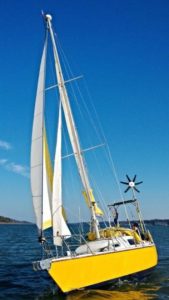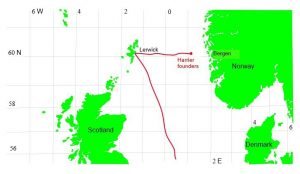Off to a good start

On the morning of Saturday 3 October 2015, in favourable conditions, I set off from the Shetland Islands towards Bergen in Norway, 200 miles away. I was aiming to spend the summer of 2016 in the Baltic Sea while I visited many of the cities and towns associated with the medieval Hanseatic League.
To begin with all went well. During Sunday 4 October a sailing breeze from the southwest carried me eastward in good style. Monday brought unexpectedly calm conditions. The sea was tranquil, the sails flapped idly and the autumn sun was warm to the skin.
Adverse conditions, ailing boat
During the following night the wind returned, but not from a favourable direction nor with a comfortable strength. It came in from the east and soon increased to force 7-8, a near gale. Harrier could not make progress against such a wind. I hove-to to wait until the forecast wind should return. Harrier lay quietly under a fully-reefed mainsail as the three and four metre waves rolled past to the west.
At dawn the next day the strong contrary wind continued to blow beneath a heavy grey sky. I could not receive additional radio weather forecasts in the middle of the North Sea. I deployed the sea anchor and settled down to await a change in the weather. That night life on board was uncomfortable and wet, but not dangerous.
The following day, I sensed something was wrong with our motion in the seas. I quickly found that the steering gear had failed. The tiller on Harrier was connected to the rudder stock by means of a hefty block of stainless steel, weighing about two kilos. The entire stainless steel block had split into two pieces along the line of the rudder stock hole. It was now impossible to steer the yacht or effect a repair. I would have to be towed back to harbour.
My call for help
Most parts of the North Sea are quite heavily trafficked. I radioed an oil industry patrol ship, the Prospector, and asked them to enquire if the Shetland lifeboat could come out nearly 100 miles and tow me back to
Lerwick. The Lerwick coastguard aassumed that my situation was dire, and proposed to send out a rescue helicopter. Via Prospector I was able to reply that I required a tow, but I didn’t need rescuing by air or in any other way. With some difficulty, I convinced Lerwick that I was not asking for rescue. Lerwick concluded that I was too far from Shetland and beyond the range of their lifeboat. They radioed Norway to ask the Norwegian coastguard service to send out a ship to fetch me and tow me to harbour in Norway.
During the following night, Harrier continued to drift downwind in safety but not under control. On the horizon downwind I could see the bright lights of the Alwyn North gas platform. Gas platforms are dangerous places, where highly volatile and inflammable materials are recovered and processed. There was some anxiety aboard Alwyn North that Harrier might collide with them. However, I could see that we would drift near but not onto the platform. In the event we passed about two miles clear to the north and out into unencumbered waters.
The east wind abated, and at first light on 8 October it was blowing at only a Force 4. The seas had gone down and life aboard Harrier became less uncomfortable. We continued to lie to the sea anchor but Harrier, without her steering, could not be navigated.
Assistance in view
Soon after dawn, a Norwegian patrol boat, KV Bergen, came into sight. Bergen was a small warship with a full naval crew. She offered to tow me to Norway. provided only that I left Harrier and came aboard the ship. There seemed to be no alternative. I reluctantly agreed to leave Harrier, and after scrambling onto their rigid inflatable boat (RIB) I was taken aboard the Bergen.
Harrier was attached to Bergen’s stern by a long warp astern and the tow began, in apparently good order, towards the coast of Norway rather less than 100 miles away. I agreed with the captain, Lieutenant Commander Vorland, that we should proceed at a low speed that was safe for my boat. Harrier was floating buoyantly astern and the Bergen was steaming ahead at a modest five knots. Once aboard KV Bergen I realised that I was very feeling tired and battered. I got into a bunk and fell into a deep sleep, confident that I was now in the hands of the professionals, and that all would be well.
A bitter goodbye
I awoke later that afternoon to be curtly informed that Harrier was sinking. What?!! I was told that she had been taking on water and was now towing astern in a half-submerged condition. I went to the ship’s bridge from which I could see my lovely little boat struggling for her life. Slowly she sank lower into the water. One last time her bow came up out of the water, as if she were gasping for breath. Then her hull slipped beneath the surface, her mast sank into the water, the tow rope snapped and Harrier disappeared from sight for ever. I felt as if I were watching an old friend drown.
Harrier was a tough and tested sailing boat. She had taken me on a 40,000 mile voyage all the way around the earth in perfect safety. On several occasions we had sailed successfully through very bad weather in the open oceans of the world. She was small, but she was a strong and very weatherly vessel. At the time that I went on board KV Bergen, Harrier was in perfect order, apart from the broken metal component in the her
rudder.
I believe Harrier could have towed successfully behind the Bergen for hundreds of miles at a moderate speed. I do not know why the Bergen accelerated to a speed that was unsafe and damaging to the boat that she was towing. I do not know why the Bergen did not slow down when she saw that Harrier was in distress from being towed too fast. I do not know why I was not consulted as to the proper conduct of the tow. Whatever the explanations may be, Harrier had been towed under and was gone. With her, nearly all my possessions and much of my small amount of money sank to the bottom of the North Sea. Without Harrier I was homeless, nearly destitute and a shipwrecked sailor.

Some months later I wrote to the Norwegian Coastguard to ask for compensation for the sinking of Harrier. I was brusquely refused. An official organisation furnished with statutory powers will play the game according to its own rules. Matters were ever so, all the way back to the time of the Garden of Eden.
Listen to: The Sailor Who Lost Everything – part of Radio 4’s The Untold, which describes what happened after Harrier had gone.